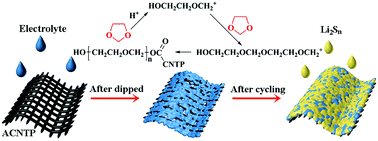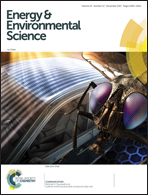Ad hoc solid electrolyte on acidized carbon nanotube paper improves cycle life of lithium–sulfur batteries†
Abstract
The performance of lithium–sulfur (Li–S) batteries is greatly improved by using acidized carbon nanotube paper (ACNTP) to induce in situ polymerization of ether-based DOL/DME liquid to grow an ion-selective solid barrier, to seal in soluble polysulfides on the cathode side. The Li–S battery with the in situ barrier showed an initial specific capacity of 683 mA h g−1 at a high current density of 1675 mA g−1, and maintained a discharge capacity of 454 mA h g−1 after 400 cycles. The capacity decay rate was 0.1% per cycle and a high Coulombic efficiency of 99% was achieved. Experimental characterizations and theoretical models demonstrate the in situ polymerized solid barrier stops sulfur transport while still allowing bidirectional Li+ transport, alleviating the shuttle effect and increasing the cycling performance. The soft and sticky nature of the solid electrolyte barrier makes it a good sealant, forming an enclosed catholyte chamber on the sulfur side.



 Please wait while we load your content...
Please wait while we load your content...